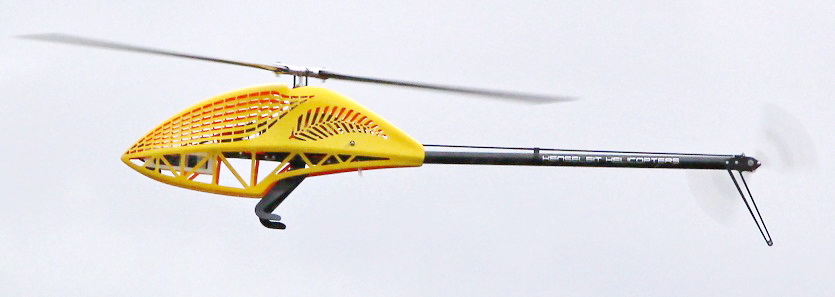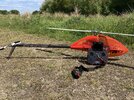Smoggie
Well-Known Member
There are loads of really nice 700 size helis on the market today, but I decided I wanted to try something genuinely different, a 700 heli that breaks all the 'rules'.
This is it:

It's a Henseleit TDSF. The 'SF' stands for 'slow flyer'. It's inspired by super lightweight 3D slow flyer planes. Jan Henseleit decided to see just how light a fully 3D capable heli could be made if you threw out the rule book. He knocked it out of the park!. Ready to fly the TDSF weighs in at 2.4Kg (5.3lb) which is well under half the weight of even a light 'normal' 700 3D heli. It's lighter than some 500 size helis but it's a true 700 that will easily accept 720mm blades. He does this trick by removing everything that's not essential (frames glued not screwed together for example) then due to the light weight you can use much smaller motor, ESC, servos and batteries compared to a standard 700. The motor and ESC are the same size as might typically be used on a Goblin 380 or 420. Servos are 'mini' size, battery is a 5S 4400mAh.
So you might think that such a puny motor and ESC would leave the TDSF very under powered... think again! :
Jan is retiring from making new helis but it making one last batch of the TDSF. I managed to get my name down for one. they are all being hand made so I'll have to wait till May to get mine but the way things are going it will be that long before the lockdown ends, so timing should be perfect!
This is it:

It's a Henseleit TDSF. The 'SF' stands for 'slow flyer'. It's inspired by super lightweight 3D slow flyer planes. Jan Henseleit decided to see just how light a fully 3D capable heli could be made if you threw out the rule book. He knocked it out of the park!. Ready to fly the TDSF weighs in at 2.4Kg (5.3lb) which is well under half the weight of even a light 'normal' 700 3D heli. It's lighter than some 500 size helis but it's a true 700 that will easily accept 720mm blades. He does this trick by removing everything that's not essential (frames glued not screwed together for example) then due to the light weight you can use much smaller motor, ESC, servos and batteries compared to a standard 700. The motor and ESC are the same size as might typically be used on a Goblin 380 or 420. Servos are 'mini' size, battery is a 5S 4400mAh.
So you might think that such a puny motor and ESC would leave the TDSF very under powered... think again! :
Jan is retiring from making new helis but it making one last batch of the TDSF. I managed to get my name down for one. they are all being hand made so I'll have to wait till May to get mine but the way things are going it will be that long before the lockdown ends, so timing should be perfect!



